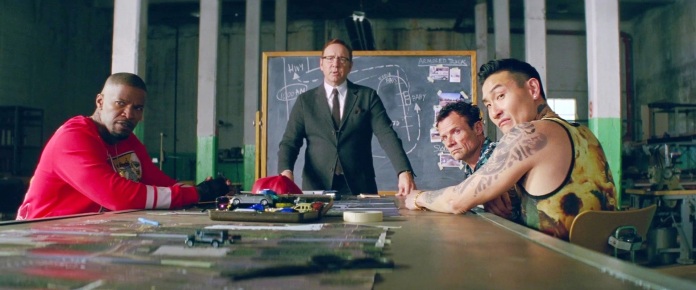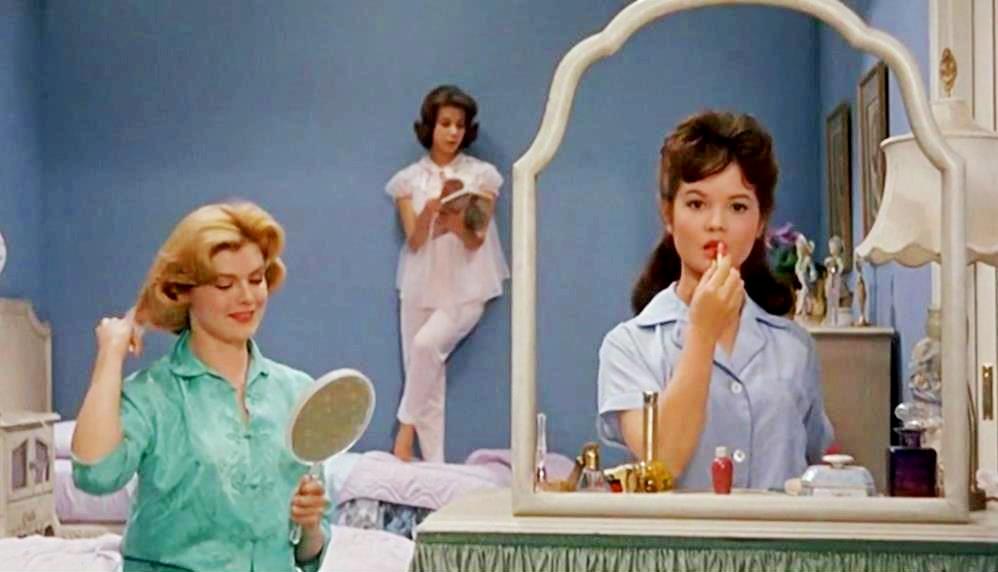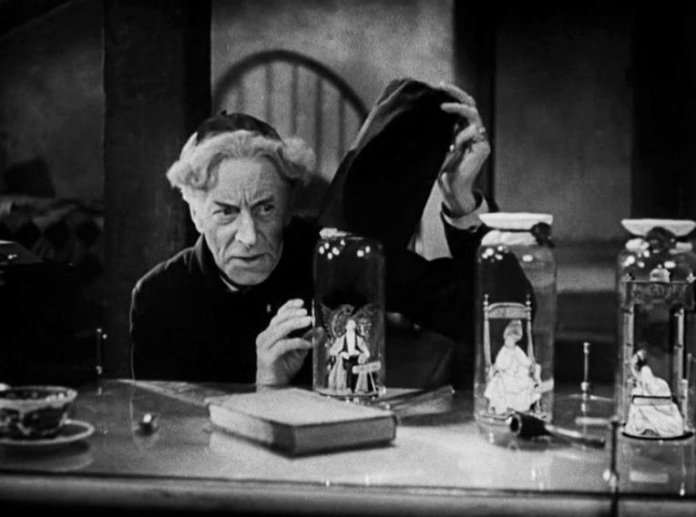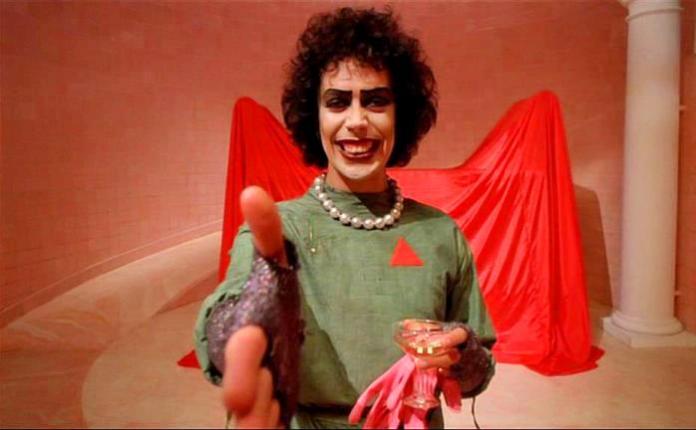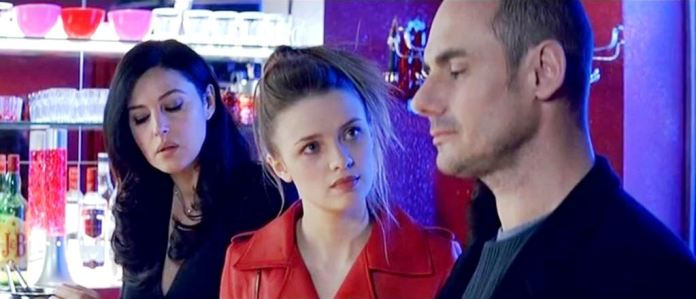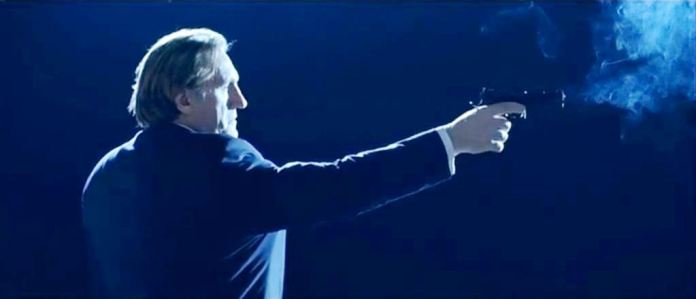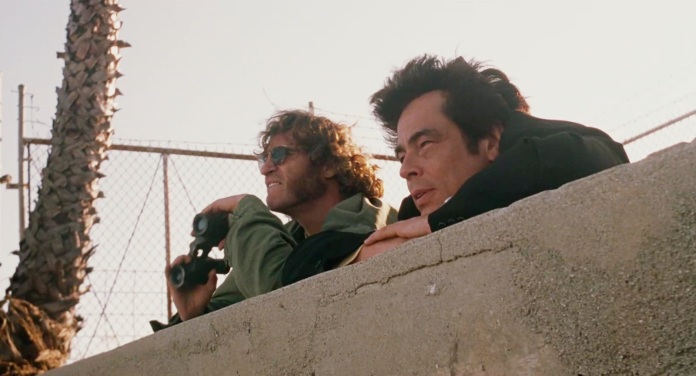Je, Tu, Il, Elle / Toute Une Nuit
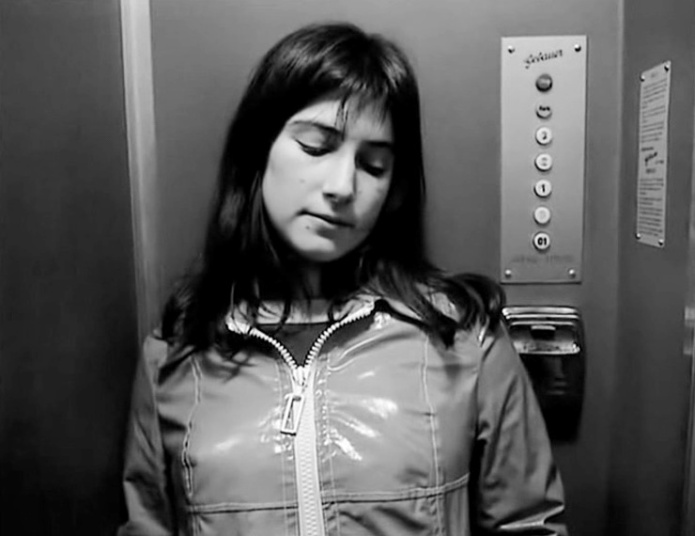
.
Director/Screenwriter/Actor: Chantal Akerman
By Roderick Heath
Chantal Akerman’s death in 2015 at the age of 65 was a wrenching moment for many movie lovers, and closed curtains on a career beloved in the most studious corners of the world cinema scene. Akerman staked her claim to such loyalty with her most famous work, Jeanne Dielman, 23 quai du Commerce, 1080 Bruxelles (1975), a three-hour situational study of a woman slowly succumbing to inchoate and murderous impulses even whilst seeming to subsist in a humdrum life of domestic trifles interspersed with casual prostitution. The film’s implications as a tract against domesticity and determination to place the minutiae of such drudgery at the centre of the cinematic focus made it a clarion work of feminism as well as artistic ambition. Akerman herself, queer, Jewish, daughter to holocaust survivors, knew very well she could represent an outsider for every occasion, even as she sometimes fought to avoid being pigeon-holed by such moulded identities, instead using them as vantages for peering, alternately fondly and ruthlessly, at the world about her. The depression that finally ended Akerman’s life seems to flow through her work like a subterranean river, but so too does a note of spry and endlessly fascinated contemplation of the habits of humans being, whether alone or in pairs or as communities. The essence of a creative person’s life, which involves a great deal of being alone and wrestling with webs of memory and thought, became a key component of Akerman’s often self-reflexive approach to her art, and many of her films are, if not necessarily autobiographical, quick to foreground themselves as self-portraiture. With the inevitable extra dimension of awareness that quite often an artist is never being more elusive than when seeming to put themselves at the centre of their art.
.

.
Akerman, born in Brussels, began a peripatetic life, first heading to Israel and then to New York for a time. She took inspiration from filmmakers including Jean-Luc Godard, whose Pierrot le Fou (1965) sparked her desire to make movies, Jonas Mekas, and Michael Snow. According to legend she financed her early short films like Saute ma ville (1971), by trading diamond shares in Antwerp and even stealing cash from a porn theatre where she worked. Akerman’s labours soon advanced to over the one-hour mark with the quasi-experimental feature Hôtel Monterey (1972). Je, Tu, Il, Elle, or Me, You, Him, Her, looks like a crude sketch for the aesthetics she would advance on Jeanne Dielman, although it would not see proper theatrical release, ironically, until the year after the subsequent movie. The subject is isolation amidst a theoretically bustling world, and the fate of those whose habits and hungers seem to exclude them from a supposed main flow of life nobody is sure actually exists anyway. Je, Tu, Il, Elle wears its limitations on its sleeve as reportage from the fringe, with the faintest echoes of literary progenitors ranging from Charlotte Perkins Gilman’s “The Yellow Wallpaper” to Fyodor Dostoyevsky’s “Notes from the Underground,” but stripped of overt neuroticism and all but the faintest dramatic development and sociological inference. Whilst undoubtedly distinctive and an original force, there are qualities to Akerman’s filmmaking that calls readily to mind that peculiar trove of Belgian surrealism practiced by painters like Rene Magritte and Paul Delvaux and the writer Jean Ray. Their creative worlds were replete with strange, transformative mythologies in the midst of an utterly banal and buttoned-down urban landscape, apt for a tiny country pointedly cut off from the greater continents of self-mythologising that are luxuries of bigger nations, where stolid surfaces and crepuscular indistinctness gave rise to somnolent fantasias where sensual selves threaten to bust the fabric of overwhelming stultification.
.

.
Je, Tu, Il, Elle plays as something of an accidental companion piece to, and temperamental inversion of, another major French-language film shot around the same time, Jean Eustache’s The Mother and the Whore (1973). Both films share a harsh, basic monochrome visual palette and deal implicitly with the ramifications of upheaval amidst young bohemia following the end of the ‘60s and resettlement with a fresh but thorny set of problems of self to overcome, particularly in the realm of sexuality, played out in bland rooms and confines of the new cityscapes. That said, the differences are as marked as the similarities. Where Eustache’s film is gabby and floridly intellectual in its approach to the politics of lust, Akerman wends at an opposite extreme, with an artistic approach she dramatizes in the first half-hour of Je, Tu, Il, Elle. Akerman plays her own protagonist, Julie, her lucid eyes jewel-like in the black-and-white photography and traces of sceptical humour always sketched around the corners of her mouth. The film’s first spoken words, “And so I left,” sarcastically suggest we’re watching the end of something rather than the start, and Julie spends a great bulk of the film in a state of retreat, boxed up in the tiny room she has rented. The title offers a basic map of the narrative, such as it is. We have the Je, that is, Julie (J-E). Il and the Elle come later. Tu remains vague, a missing fourth party, which could be whoever Julie has left at the start, or who she begins writing a very long letter to, or the composition itself. It’s also, of course, the audience, watching her through the screen.
.

.
Akerman’s early works had been defined by her fascination with and unease in those functional spaces, the average room – not for nothing had she made two shorts both titled Le Chambre during her first sojourn to New York in the early 1970s. Julie begins a rigorous process of divestment, at first getting rid of some items of furniture, then all of it, including her drapes and only leaving herself a mattress to sleep on. She even supposedly changes the colour of the walls, although that can’t register to the camera. “I thought the space looked bigger,” is the only explanation she offers for this process. Akerman’s activity here mimics her own approach to cinema, in trying to strip out affectations and reduce the proposition of the art itself to a basic matter, to give its expression the new lexicon she sought. Scenes flit by in a succession of lengthy shots where Julie’s voiceover describes all the action that will occur depicted in quick missives and then play out duly and at length, with the pace of shots only timed by what Akerman confessed was her purely instinctive internal clock. At the same time, Akerman also satirises her efforts, as Julie tries to write a “letter” that seems to become thesis, confession, and manifesto as it goes on, and after several pages – perhaps a reference to her own juvenilia as a director – she realises she’s been saying the same thing over and over. Slow fade outs punctuate most shots as time loses function and space becomes a mere containment for exploration of the interior world. As time ceases to exist for Julie, so does any notion of sociability or propriety. By the end of the process she’s become some kind of entomological phenomena, existing purely on raw sugar whilst scribbling down her thoughts.
.

.
The biggest event on one of her days comes when she accidentally spills some of the sugar over her pages and has to scoop it back in spoonful by spoonful. When she finishes writing her epistle, she spreads the pages out on the floor and reads them, and then takes off her clothes. Akerman proceeds to film her nude self in postures and compositions reminiscent of Degas, Botticelli, Vermeer. The act of communication leaves one entirely naked, and yet still not defenceless. Julie’s window remains her portal on the world, and also the world’s portal on her. When she sees a man pass by the window, she remains close to the glass for hours attempting to attract someone’s else’s eye to verify her existence. The window becomes the cinema screen itself, actualising the problem of trying to create something interesting enough to fill it with Akerman’s stark tools. All Julie’s view offers is a dull and snow-crusted suburbia, where humanity barely ever appears, whilst the view from without for anyone who might notice is of a near-naked woman. Akerman turns her very body into a canvas and yet reveals nothing. There’s also has the added aspect of a joke about forlornly frustrated sexuality, a joke that echoes on through her work. Julie’s free advertising yields no customers but when she ventures out into the world she finds an agreeable sexual transaction to make. Finally Julie is driven out of her room after realising she’s been there for nearly a month without excursion. Her entry into the world is represented by a single, hilariously cheerless vision of a highway junction on a rainy day, traffic flowing this way and that in the grey and hazy morning. This is the first proper exterior shot of the film, 33 minutes in. Julie hitchhikes into inner Brussels, and is picked up by a truck driver (Niels Arestup, in his film debut; he would much later star in films like Jacques Audiard’s Un Prophet, 2009, and Steven Spielberg’s War Horse, 2011).
.

.
Julie and the driver find mutual accord in their initial disinterest in any form of conversation, as both are engaged in a form of sanctuary involving their labours, Julie as someone who’s excised herself from common reality by her creative perspective, and the driver as a workman who’s used to the silent, solitary vicissitudes of his job. The funniest vignette in the film comes when the driver pulls over and the two eat in a diner whilst watching an American thriller on the television, the blaring sirens, gunshots, and funky music filling both diner and soundtrack (I’d swear I heard Clu Gulager’s voice in there somewhere). Julie and the driver eat wordlessly as they gawk at the action playing out on the screen, saving them from the tyranny of human beings’ propensity to remain utterly alien to each-other. Akerman is both wry here about the frenetic business of entertainment whilst also acknowledging its appeal in a landscape that is otherwise entirely devoid of stimulation. Julie spends most of the time travelling with the driver admiring his neck, which seems to her beautiful in its firm and rigorous masculinity, whilst he’s hunched over wrestling the wheel of the truck. Later the driver takes Julie into a roadside bar he frequents and introduces her to this little world of working men. Finally, she jerks him off when they’re parked. “You see,” the driver gasps as she works away, face contorting in pleasure-pain: “The only thing that matters.” When he ejaculates, he narrates the experience with a deft poetry: “It came in little waves.”
.

.
Akerman shoots this scene in such blazing intimacy the sound of the camera can be heard on the soundtrack. The poetics of banality are Akerman’s field of play throughout Je, Tu, Il, Elle, as she offers this transient world of incidental intimacy and grimy, quotidian peregrination with a perverse fondness for the desolate environs she surveys, rendering all the more intriguing, and frustrating, the free-floating atolls of humanity she encounters. Julie’s time with the driver is both amiable for the most part but also desultory: the driver demands nothing more from Julie than that salutary hand-job and offers no more than a cheap ride to wherever. He does finally become chatty afterwards, and describes his life in a long monologue, recounting his happiness in his early married life when he and his wife were frantically horny, but bit by bit he’s had his sex life choked off by his work and his children. He finds himself both amused and annoyed by his insolent eleven-year-old daughter’s nascent, taunting sex appeal, so he takes whatever pleasure he can with hitchhikers like Julie. Julie listens to all his story, even the perturbing parts, with a grin of midnight solidarity and patience. Later, Julie watched the driver shave with an electric razor in a truck stop bathroom, finding something epic and sensually gratifying in the act of witnessing this arcane male ritual.
.

.
Finally the driver drops her off in a town, and Julie seeks out a female lover (Claire Wauthion) who lives in the vicinity. The lover tells Julie she can stay the night but has to be gone in the morning. Julie accepts the condition and then speaks aloud for the first time in the film: “I’m hungry.” So the lover make her a sandwich. “More,” Julie demands. Love is making someone else a sandwich. Or is it? Julie’s reduction to a strange kind of barely-speaking beast by this point, ejaculating blank requests, suggests the odd kinship between her and the driver. In the end, all that matters is who can sate one’s hungers. The film’s last fifteen minutes is almost entirely devoted to the spectacle of Julie and her lover in bed, lost in a gleeful tangle of limbs, providing a climax in both senses of the term. This sequence probably had some confrontational kick in the context of 1973 in offering an unblinking view of lesbian sexuality unparsed by pornographic impulse. Now it’s a perfectly straightforward and charming depiction of physical joy and evident emotional fervour painted on the faces of Akerman and Wauthion. Even here however Akerman, whilst seeming finally to resolve the ache at the centre of the film in its contemplation of the spaces between people, maintains ambiguities. Akerman’s sparing approach to giving any dramatic context forces questions as to why the lover is so insistent Julie cannot stay. She seems to live alone, but may have other lovers, or she might simply have great affection for Julie that isn’t quite enough to blind her to Julie’s self-involvement. Perhaps as well as “her”, she’s also the “you” of the title.
.

.
The film closes off with a quotation from the poet A.E. Housman – “We’ll to the woods no more. The Laurels are all gone.” – that gives the film both a grinning quality as another sex joke, for Julie has gathered the laurels and then some, but also a covert note of despair, for Housman’s poem is one of prospective death for an elderly man, and even in the wake of great pleasure and fulfilment Julie is all too aware that solitude and fate are still stalking her. Nine years later, Akerman would return to the theme of watching people try to connect in a twilight world with Toute Une Nuit, when her style had much matured and her budgets had at least increased enough to shoot in colour. Toute Une Nuit’s approach to coupling and the life nocturnal is radically different in other ways to that in Je, Tu, Il, Elle, as here Akerman, instead of offering monomaniacal focus upon a version of herself, now moves at high speed through an entire panorama of vignettes, most describing some particular moment and method of loving. The setting is an inner suburb of Brussels. Some of the vignettes are returned to as the film unfolds, eventually coalescing into a disjointed quasi-narrative, but most are not, left as precise thumbnail sketches of what could be called moments of truth. Some moments are comedic, others tragic, still more wistful and sexy.
.

.
Although her narrative approach retains an edge of abstracted essentialism and her visuals remain stark and unfussy, the mood Akerman weaves in Toute Une Nuit has a peculiarly classical feel, calling back to a bygone romanticism of directors like Max Ophuls, Vincent Minnelli, Billy Wilder, Jean Renoir. Ophul’s La Ronde (1950) seems a particular touchstone, or, if you prefer a less high-falutin’ reference point, call it all Love, Belgian Style. Her women are quite often seen in flashes of retro chic, swathed red dresses and silk nightgowns, and sport heels that crack out a nervy beat wherever they tread. Men wear baggy suits ready to perform a Gene Kelly dance routine in. The film’s dark palette and Akerman’s mostly removed camera, with a paucity of close-ups, means that many of the people remain vague. Their interchangeableness as well as their pining specificity is part of the point, and their adventures overlap and intermingle like charts of logarithmic variants. A couple of familiar faces flit by – Aurore Clement, who had already played another Akerman avatar in Les Rendez-vous d’Anna (1978) is in the mix, as is a young Tcheky Karyo. Otherwise we’re navigating here less by faces than by landmarks, the places that become lynch-pins for the dance of night – the square at the heart of the neighbourhood, the tavern and apartment buildings and shops that front it, and a host of houses a distance down radiating streets.
.

.
The film’s title comes from dialogue in one vignette, in which an infuriated husband walks out on his wife; she chases him, he embraces her, and as they stand clutching each-other on the pavement she murmurs, “We can’t stand here all night long.” To which he replies, “The hell we can’t.” The intensity of the need for others that drives people wild is a basic and insistent note sounded throughout the film in its daisy-chain of fierce embraces and ruptures. The concentration on a nocturnal atmosphere, the visions through windows at brief sketches of behaviour, evoke Edward Hopper’s gently suggestive blend of naturalism and surrealism and fascination with the gallery of the urban as a window into manifold souls. The first few episodes quickly establish a comic rhythm and temperament for the film which the rest of it shades and revises without spurning. A woman (Clement) in a red dress treads fretfully in her room, calls up a man, but hangs up without saying a word: she murmurs desperately, “I love you—I love you,” and then catches a taxi and stands in the square, gazing up at the silhouetted object of her affection as he paces about his apartment. Later, after returning to her room, she hears a knock on her door, and opens it to find another man who’s in love with her. She invites him in in spite of her disappointment it’s not the other man.
.

.
In the bar, a woman in a coat the same shade of red sits waiting alone at a table. Her man turns up at the door, clutching a suitcase, and embraces her. Meanwhile a young man and young woman occupy nearby tables, obviously both lovelorn and in their body language intensely aware of each-other. The man gets up to leave and walks out of the frame, then dashes back and embraces her. They dance around the bar in close and clingy fashion. A trio of teenagers occupy a booth in the bar, two boys and a girl. One of the boys irritably gets up to leave, the other two follow him onto the pavement, and the first boy makes a demand of the girl to choose between him and the other boy. The girl’s silence drives both boys off in different directions, and she waltzes on her own path. A small girl leaves home with a suitcase and her pet cat in hand. Another insists on dancing with the bar owner to a cheesy Italian pop song that recurs throughout the film, beckoning, like the cop show in Je, Tu, Il, Elle, with fantasies of a larger, more intense way of living. One teenage girl flees her family home with her boyfriend, glimpsed hopping the back fence through a window.
.

.
The shrugging, carefree, protean spirit of such youth contrasts the generally older, more fretful tenor of the unions Akerman surveys. Some happy and tranquil couples are noted, whilst people who are feeling the pinch of solitude or sweltering in troubled relationships are also portrayed. Akerman casually allows queer relationships space. A lesbian couple is sundered when one woman finds her partner has a man in her room. A gay male couple are awakened in the night as one has to make an early start on a journey, and his partner gets up again a few hours later to a dismally empty apartment, so he settles down to write a letter to his absent lover. One middle-aged wife turns off the television and suggests to her husband they go out dancing, and he happily agrees, so they head out hand in hand. Another husband packs up and walks out during the night. A wife does the same thing, leaving her sleeping mate in bed, donning some lipstick, and then marching out into the dark. She’s glimpsed occasionally throughout the rest of the film. She rents a room at a hotel, and flops down on the bed in her room, only to then abandon this domicile too and wander about the square, and at last returns home. She slips back into bed next to her husband who has remained oblivious throughout her odyssey, seconds before her alarm clock goes off and stirs her to start her day proper with pitiless regularity.
.

.
This lady might well be the most luckless and forlorn in the film, her homecoming charged with a bitter taste, although the seamlessness of the chain of motions that puts her in bed and then draws her out again gives a grand comedic aspect too, like a Jerry Lewis or Jack Lemmon character who’s bitten off more than they can chew in their lifestyle. And how many times has she traced the same roundelay, obeying the call to some other life and then trundling wearily back to the old one that at least offers structure, even in such voyages? Akerman notes a similarly phenomenon with another couple who, after knowing a night of passion, propose to run away to Italy together, only for the woman to dash off whilst the man pays his hotel bill. Like Julie in Je, Tu, Il, Elle, who comes from nowhere and returns there as far as the camera is concerned, so too do the people witnessed in Toute Une Nuit. On one level the film is a sleek and lovely entertainment, but it’s also one that sees Akerman finding an honourable, even revolutionary way of mating the theoretical bent of her early work with more populist impulses. The contained and singular self Julie offered Akerman as avatar in Je, Tu, Il, Elle is here also split across manifold persons, as different characters repeat gestures seen in the earlier film.
.

.
Akerman’s reticence in revealing much about the hows and whyfors of what we’re seeing, carried over from her earlier work and instead insisting merely on observing moments in all their random and fleeting fascination, might make such vignettes seem lightweight, but somehow their concision instead imbues a sense of privilege upon their witnessing. The artistic process of plumbing the mysteries of things glimpsed and voyeuristically observed is both exposed and also imposed upon the audience, an openness that invites the viewer to paint in their own assumptions about what drives many of these characters and define their problems. Like Julie, they’re both contained safely in and tormented by the spaces about them, the oppression of walls and windows, and eventually most flee their confines to snatch at their chances in a shared zone. Romance isn’t the only thing Akerman scrutinises, as she also contemplates the drives and motives that lead some to be alone. She notes a man who seems to run a textile store putting his accounts in order, working into the wee hours, tapping away remorseless on his adding machine. Eventually he falls asleep at his post and awakens later to wander the store, surrounded by the stuff of his trade, rough and unmade sheathes for the bodies at large in the film sprawled ghostlike about him. A writer awakens in the darkness and sits in sleepless agony as he parses his artistic problems. Matched patterns and unconscious acts of mimicry are noted as Akerman trains the camera up from the square to notice two men in stacked apartments, both perched upon their balconies in meditative angst. Perhaps the most magical moment comes when a couple who may be splitting up hover at separate windows as a thunderstorm approaches, lightning strobing upon their semi-clothed bodies, the curtains billowing as ethereal beings as they would in a Delvaux or Hopper painting, the couple facing each-other in charged physical awareness that cannot quite transmute into intimacy.
.

.
The storm that threatens to break upon the town proves mild, however, and the night’s epiphanies are interrogated in the morning. The writer who hovered in angst during the night settles down and attack the page with new zest. The very end of the film circles back to the same woman it started with, still dogged by her obsessive fascination with her tormenting non-lover even as she dances with the real one before her, and an ambiguous final phone call she receives sees her finally fall into an embrace with him on a mattress just as stark and paltry and essential as the one Julie lolls upon throughout Je, Tu, Il, Elle, declaring the connection between the two films in the processes of Akerman’s mind. Akerman’s influence on some filmmakers is laid bare by both Je, Tu, Il, Elle and Toute Une Nuit, particularly upon Jim Jarmusch, who’s spent his entire career pursuing Akerman’s attitude of wistful, crepuscular dispassion. The imprint of Je, Tu, Il, Elle is notable on Jarmusch’s early efforts like Stranger Than Paradise (1984) and Down By Law (1986), whilst the collective vignettes and starkly filmed nocturnal settings of Toute Une Nuit echo throughout Mystery Train (1989) and Night on Earth (1991). Claire Denis paid tribute with her Friday Night (2002), whilst Kelly Reichardt and Sofia Coppola have admitted their debts. There’s even a dash of the Toute Une Nuit in Stanley Kubrick’s Eyes Wide Shut’s (1999) insomniac hunt for love to the end of night, and Sang Song-Ho’s behavioural studies like The Day He Arrives (2011). The laurels grow and bloom still to be picked.





